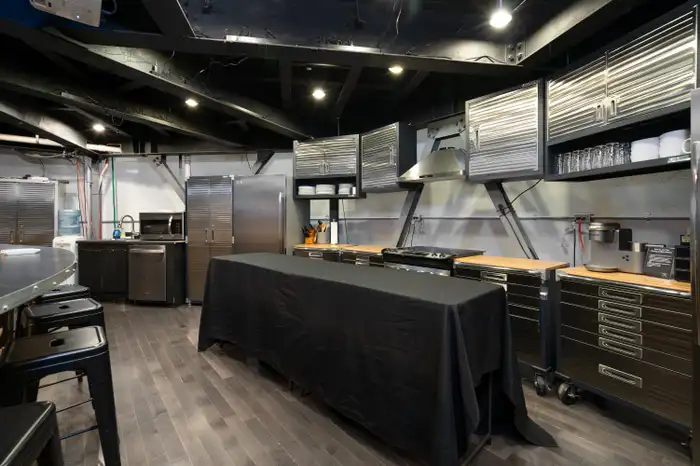I spent 10 years and $800,000 renovating an Arkansas missile silo. It’s my greatest accomplishment, but I don’t recommend others try it.

An entry into the Titan II Airbnb.
This is an as-told-to essay based on a conversation with GT Hill, a 49-year-old former director of technical marketing who lives in Vilonia, Arkansas. He bought a $90,000 decommissioned missile silo and turned it into an Airbnb. The following conversation has been edited for length and clarity.
I grew up in eastern Oregon, in the middle of nowhere, so I did welding and many other mechanical things. I was a jet engine mechanic in the Air Force and spent my primary career in technology. I worked for a handful of Silicon Valley companies as a director of technical marketing.
One day, I was getting my haircut in Searcy, Arkansas. These old guys were talking about the missile silos that were around Arkansas. I had never heard about these places that housed nuclear missiles, so I started researching.
Probably 20% of my interest was in the doomsday prepper aspect or the idea of preparing to survive in the case of a catastrophe. I’m not a full doomsday prepper, but I like the idea of being prepared for the unknown, including having food storage and some survival skills.
If you talk to the hardcore preppers, which I’m not, missile silos are not that great, depending on what you think is the worst-case scenario. If it’s a Walking-Dead-style apocalypse, you don’t want to be in a missile silo because then you’re trapped inside.
Another 30% of my interest was in the modern archaeology aspect of owning something like this. I really wanted to dig it up and see what was in there. Initially, I intended to make it a house for my family.
Lastly, I was interested in owning a missile silo because it’s just kick ass. The place has 7,000-pound doors. Its three floors are made out of a steel structure nicknamed “the birdcage.”
It’s on eight springs and actually hangs from the ceiling. And the reason is if it gets hit by a bomb, it allows the structure to shake to try to preserve the equipment and the people inside.
Thanks to the rattle space or the gap between the floors and walls, I can put my back against the wall and push the structure to get it to move.
I bought the historic silo for $90,000. It was decommissioned in the 1980s as part of an international treaty.

The silo can turn into a nightclub that hosts parties, charity events, and even acrobats.
I found my missile silo, called Titan II, online. I started talking to the previous owner in January of 2010, and by August, I owned it.
Titan II was denuclearized after the US and Russia signed a 1979 treaty to limit each country’s nuclear weapons. The US disarmed Titan II as part of that negotiation, called the Strategic Arms Limitation Talks II or SALT II.
They had to destroy the silo in very specific ways. They actually had to blow up the top of the structure and fill it in. So it was an underground structure, but completely buried.
I bought the nine-acre site in Vilonia, Arkansas, for $90,000, which was about a $30,000 premium over the land’s value alone.
There were three main components. There’s the silo itself, a 57-foot diameter structure or basically a 15-story building, which sits underground at 150 feet deep. Then there’s a long tunnel connecting the silo to the center area that’s 35 feet underground. The last part of it is the launch control center, which goes as deep as 50 feet underground.
The whole process was risky and expensive. I don’t recommend people try to copy me.

The middle floor of the control center is available to rent.
Some people look at an old house and think, “There’s no way I want to rebuild that.” I liked the challenge. I knew we could build a pretty cool place. It just took a whole lot more money and time than I anticipated.
I finally got money and time together in October 2010. I rented a large bulldozer and an excavator, and then we started digging.
The whole facility was full of water. We could see water pouring out on top of us, so we had to figure out how to open the front door of the control center without dying. When the door popped open, a huge wave came over us. It was scary.

The main bedroom is in the livable portion of the silo.
There were other challenges. The place had asbestos and methane gas at the top of the control center, where the crew quarters were. I recorded videos of the whole process, and you can actually hear my voice change because of the methane in the air.
I had much more time than I did money. It’s not that I didn’t have the money to do it, but when you get the money, how do you prioritize using it? Do you throw it in a hole in the ground or spend it on a vacation for your family? Or upgrade the current home you live in? I had to make many of those decisions over the 10-year renovation period.
After spending $800,000, we’re probably netting $80,000 a year in revenue from the place now that I rent it out on Airbnb.
People ask what the hardest part about doing this was, and it has nothing to do with the work. It’s the mental side. You’re spending money on a hole in the ground, and you have nothing to show for it. It ended well for me, but the average person shouldn’t do it.
It’s not a great way to spend time or money.
We’ve turned the missile into an Airbnb and have hosted YouTubers, acrobats, and a writer who lived cut off from the world for 10 days.

The main kitchen.
We still live on the property, but we never moved in full-time. We’d spend some nights as a family there, either for fun or as a shelter from big tornadoes.
There are no walls and doors, so there’s no real primary bedroom. The top floor has a king bed, a large, open shower, and a free-standing bathtub. The middle floor has two queen beds that we can move to make more space. Then, the kitchen and the living room are on the bottom floor, which also doubles as a dance floor and can turn into a club.
We host anything on the property, including meetings. If it’s semi-legal and people want to do it there and pay for it, we’re fine with it.
The first booking we got was in November 2020. It was a couple coming for their honeymoon, but they got a little too intoxicated at their wedding to make the trip. They sent their best man instead.
Our initial rate was $275 per night with a $75 cleaning fee. Since then, we’ve raised prices a few times, so now we’re in the $400-$700 range for a one-night stay, depending on whether it’s a weekday or a weekend.

Inside one of the bathrooms.
COVID was obviously still going on when we started to list it, and I marketed the silo as the ultimate social distancing. There was this YouTube couple, Kara and Nate, with like 3 million subscribers, who came to stay in 2021. They were travel influencers who started doing van life during the pandemic.
I would say 70% of our bookings for the next year came through the video they made about their stay. Today, I would’ve paid an influencer couple like that $5,000 to stay for that kind of exposure. With them, it was just a coincidence.
I once intentionally locked a woman in there for 10 days straight. In 2021, an author named Lynne Peeples called me and said, “I’m doing a book on circadian rhythm, and I need a place that has absolutely no indication of time whatsoever.” She wanted to see what would happen to her sleep cycle. Before her arrival, I had to ensure everything that told the time was covered; even the Netflix account couldn’t show the time.
We’ve had acrobats down there for a charity event. We’ve had bands perform. We’ve had birthday parties and even some swingers. I’m a pretty open guy. Just treat each other and the place well.
The only thing we haven’t had yet is a wedding. And a lot of the reason for that is because of the stairs. It’s five flights down, and typically, everybody’s got at least one older relative in attendance.
It’s been a pretty terrible investment, any way you look at it, but it’s become more than that. It’s now part of my identity.





